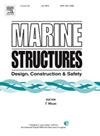Investigation and formulation of LJF in collar-reinforced K-joints under OPB in jacket substructures of offshore wind turbines
IF 4
2区 工程技术
Q1 ENGINEERING, CIVIL
引用次数: 0
Abstract
This study examines the local joint flexibility of collar-reinforced K-shaped tubular connections subjected to balanced and unbalanced out-of-plane bending moments. The accuracy of numerical models was first validated by comparing them with available experimental and numerical data. Following this, 274 finite element analyses were performed on 134 connections to investigate the influence of geometric parameters on the flexibility coefficient and the ratio of the flexibility coefficient in reinforced to associated unreinforced connections. The findings revealed that reinforcing K-shaped connections with collar plates significantly reduced the flexibility coefficient, with reductions reaching up to 90.41%, primarily due to the increased radial stiffness of the chord. Additionally, the results showed that longer and thicker collar plates led to a substantial decrease in the flexibility coefficient. Also, the effect of collar thickness becoming more pronounced as collar length increased, highlighting their combined contribution to improving connection stiffness. Moreover, the increase of β and decrease of γ result in the drop of the Local Joint Flexibility coefficient. Finally, two parametric formulas for calculating the flexibility coefficient in reinforced connections were proposed, demonstrating robustness and reliability, and providing consistency with industry standards across a range of connection configurations.
海上风力机导管套子结构OPB作用下环圈增强k型接头LJF的研究与计算
本研究考察了受平衡和不平衡面外弯矩影响的环箍加固k形管连接的局部关节柔性。首先通过与现有的实验和数值数据进行比较,验证了数值模型的准确性。在此基础上,对134个节点进行了274次有限元分析,研究几何参数对节点柔度系数以及加筋节点与未加筋节点柔度系数之比的影响。研究结果表明,用接箍板加强k形连接可以显著降低弹性系数,降低幅度高达90.41%,这主要是由于弦的径向刚度增加。此外,结果表明,更长、更厚的领板导致柔度系数大幅下降。此外,随着接箍长度的增加,接箍厚度的影响变得更加明显,突出了它们对提高连接刚度的共同贡献。β的增加和γ的减少导致局部关节柔度系数的下降。最后,提出了计算加固连接柔度系数的两个参数公式,证明了鲁棒性和可靠性,并在一系列连接配置中与行业标准保持一致。
本文章由计算机程序翻译,如有差异,请以英文原文为准。
求助全文
约1分钟内获得全文
求助全文
来源期刊

Marine Structures
工程技术-工程:海洋
CiteScore
8.70
自引率
7.70%
发文量
157
审稿时长
6.4 months
期刊介绍:
This journal aims to provide a medium for presentation and discussion of the latest developments in research, design, fabrication and in-service experience relating to marine structures, i.e., all structures of steel, concrete, light alloy or composite construction having an interface with the sea, including ships, fixed and mobile offshore platforms, submarine and submersibles, pipelines, subsea systems for shallow and deep ocean operations and coastal structures such as piers.
 求助内容:
求助内容: 应助结果提醒方式:
应助结果提醒方式:


